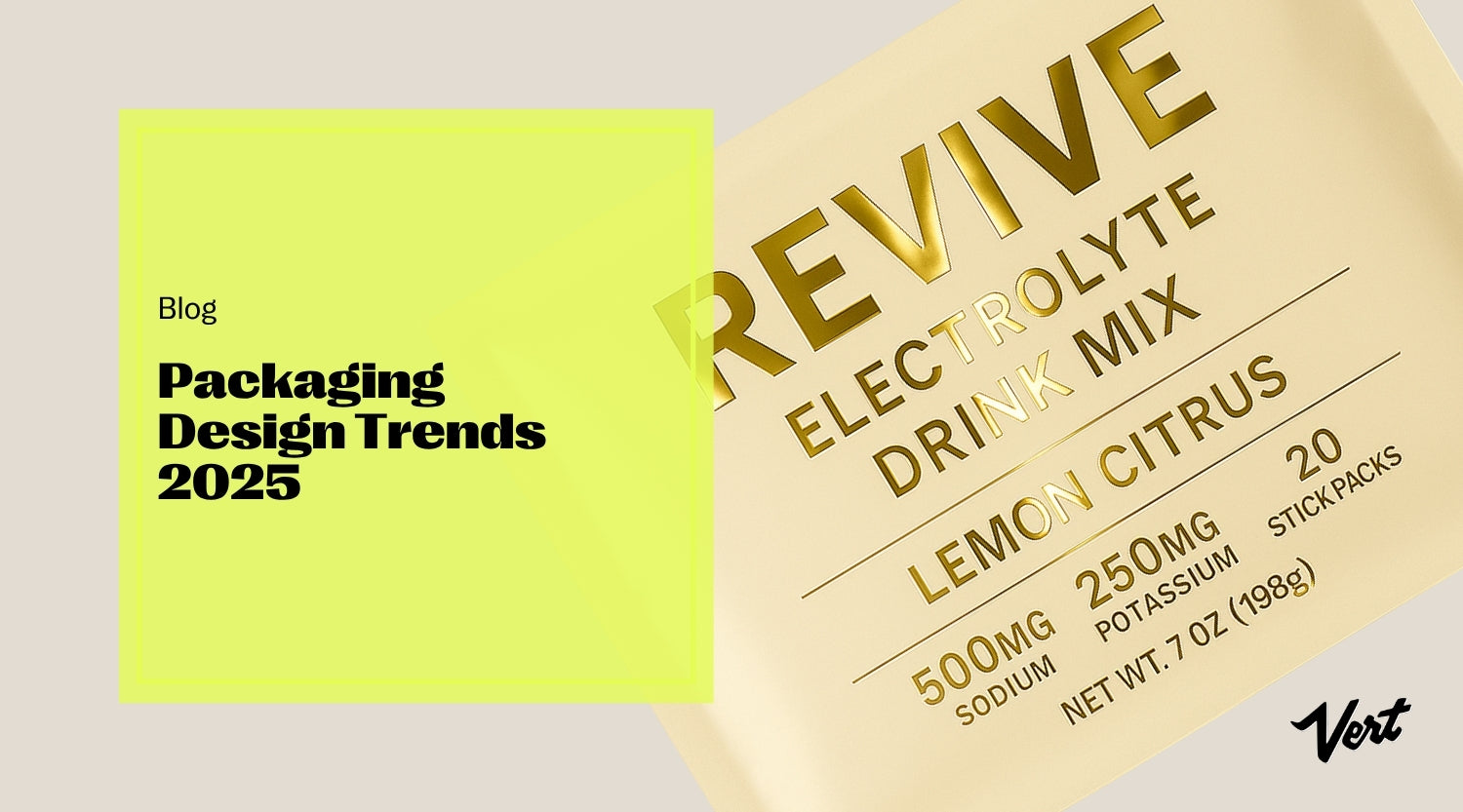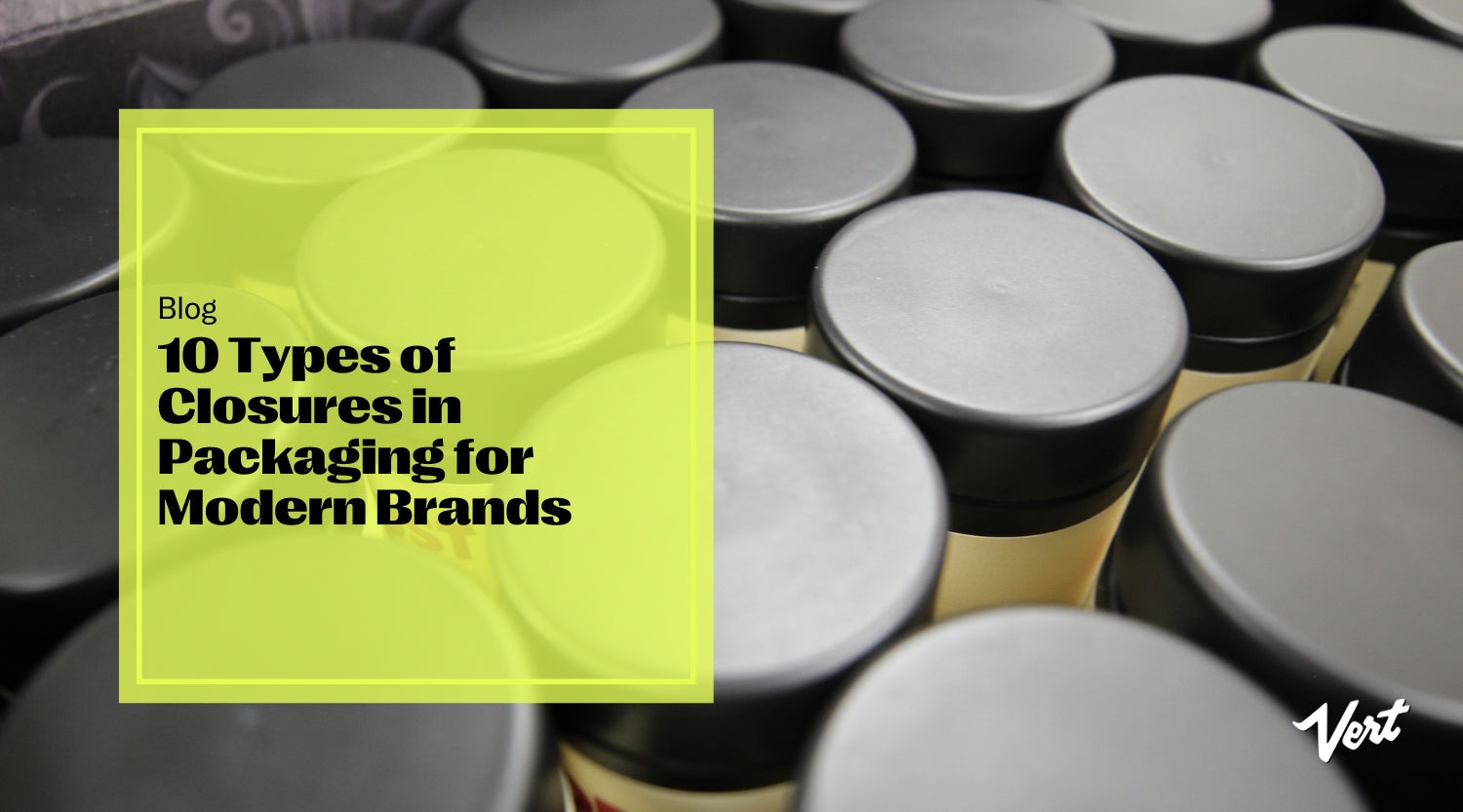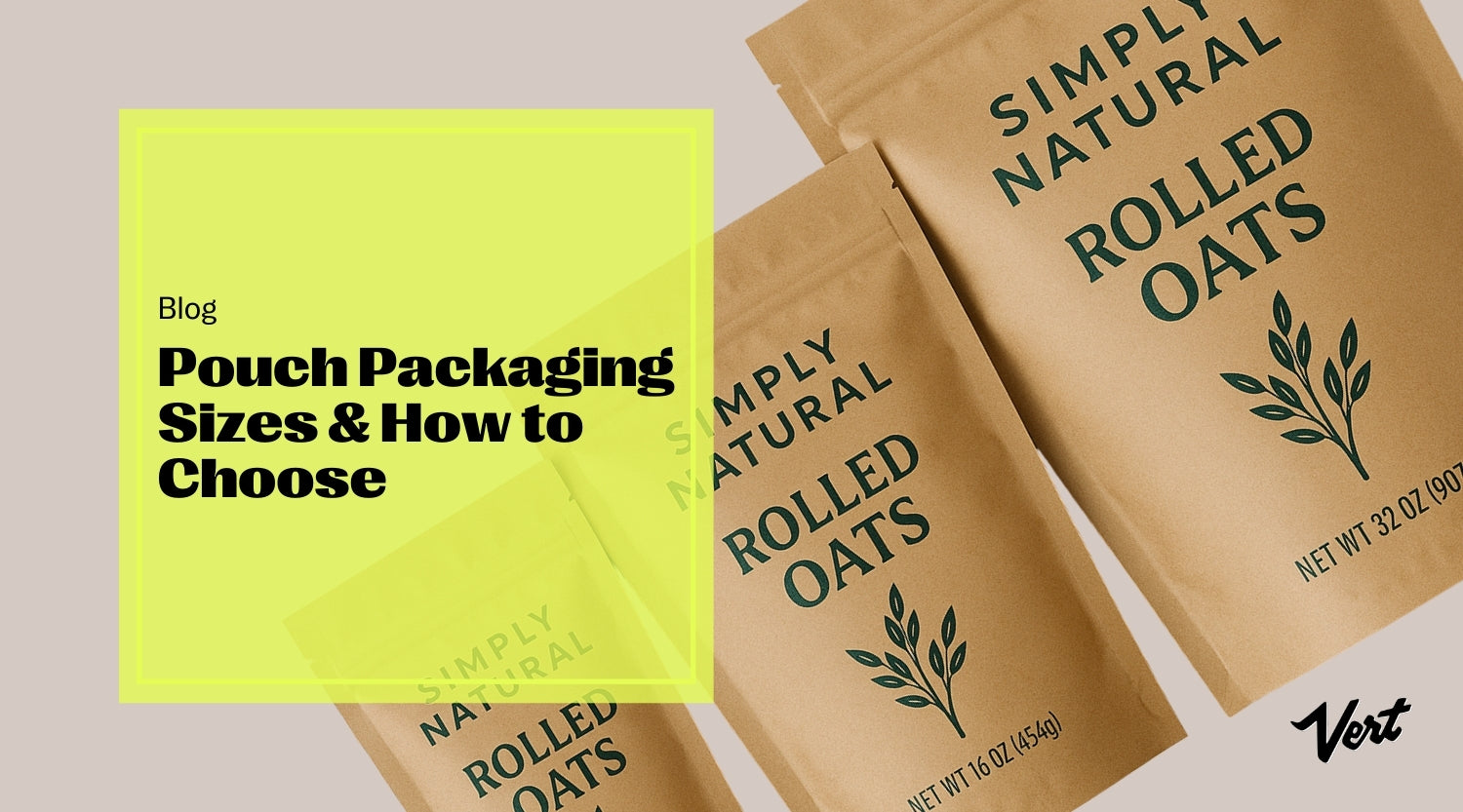Packaging design in 2025 drives customer experience, builds brand recognition, and speeds up delivery to stores.
Packaging must balance sustainability, visual impact, and user-friendly features. Brands in crowded markets need packaging that adds value fast.
Understanding packaging design trends will allow your business to choose the best option for your needs.
1. Premium Embellishments Shape First Impressions
Premium print techniques and embellishments add visual depth and tactile value.
Foil stamping, spot gloss, and raised effects increase shelf appeal. Metallic finishes like gold or silver suggest luxury. These techniques add shine and texture. A matte box with gold or silver foil looks clean and bold. These design trends add quality and luxury.
2. Spot Gloss Print Effects
Gloss and matte finishes work together to frame the message.

Spot gloss uses textural contrast to highlight key visuals. It creates focus without adding color. The result feels sleek. This packaging trend works well for health, wellness, cannabis products, and more.
3. Bold Color Palettes
Bright colors spark emotion and grab customers’ attention.
Brands use gradients and neon to stand out. Warm tones feel playful and bold. Cool tones feel calm and clean. Color builds mood and also attracts buyers.
4. Hand-Drawn Illustrations
Sketches add warmth and personality.
Loose linework feels honest. Hand lettering stands out in a digital world. This style works well for natural food as well as wellness brands. It feels like a person made the product, not a machine.

Caption: Collab packaging with hand-drawn artwork by Lenny Vuitton
This rustic and creative packaging design approach creates a sense of trust through imperfection. Consumers often associate it with authenticity. It also helps smaller brands feel approachable.
5. Y2K-Inspired Visuals
Early 2000s looks are back with a modern twist.
Think holographic shimmer, bubble fonts, and pastels. These designs feel playful and nostalgic. They connect with younger shoppers. The vibe is light and fun. It’s made for social media.
Y2K-inspired packaging pops on shelves and on social media. It taps into the trend cycle while staying fresh. It turns everyday products into shareable moments. Soft gradients and sparkly finishes catch the eye. This look feels playful and approachable.
6. Minimalist Luxury
Simple design feels clean, calm, and confident
Black and white palettes feel timeless. Thick paper and soft finishes add weight. The layout stays clean. No clutter. Premium brands trust quiet design to do the talking.
Embossed logos catch the light without shouting. Matte textures invite touch and suggest quality. White space draws the eye to key details. The result is packaging that feels intentional.
7. Sustainable Materials with Texture
Eco-friendly materials show commitment to the planet.
Recycled paper, kraft board, and plant-based films reduce waste. They also offer a natural, honest look. Texture adds character. Rough paper feels raw and handmade. These choices support both values and visual appeal. Fibers, specks, and imperfections tell a story of reuse.
Uncoated finishes avoid gloss and reflect a low-impact ethos. Minimal printing keeps the design grounded and cost-effective. This style resonates with eco-conscious shoppers who seek transparency. It signals that the brand cares about more than just aesthetics.
Statista reports that consumers want more eco-friendly packaging. Many see it as a key part of sustainable shopping. Recyclable and non-plastic options rank highest across global surveys.
8. Transparent Elements
Clear packaging builds trust by showing the product inside.
Windows and see-through labels let customers view what they are buying. This adds confidence. It also highlights color and texture. Transparency works well in food, skincare, and supplements.

A clear jar filled with vibrant gummies looks fresh and honest. Frosted plastic offers a soft, diffused peek at lotions and oils. Layered films reveal ingredients or layers inside the product. Glossy windows on kraft boxes mix raw and polished. This style feels modern, open, and real.
9. Natural Material Fusion
Mixing materials adds texture and tells a richer story.
Wood lids, cork details, and cloth ties create depth. A box with fabric or grainy paper feels thoughtful. These touches connect with nature and suggest quality.
A candle in a glass jar with a carved wooden lid feels grounded and refined. Linen wraps or bands add a tactile element to wellness goods. Hemp twine or raw leather tags enhance the handmade appeal.
Small details, like hand-sewn edges or recycled string, signal care. These elements invite customers to slow down and notice.
10. Color-Shift Effects
Inks that change color add movement and surprise.
These effects shine at different angles. They grab attention in stores and online. The shimmer suggests innovation. It works well for limited editions and tech-forward brands.
Holographic foil glints pink, green, and silver with each tilt. Labels that shift from blue to violet feel futuristic. Gradient metallics pulse under retail lighting. These visuals demand a second look. They make even simple packaging feel premium.

Creating Memorable Brand Moments
Packaging creates emotion fast. It builds loyalty through design.
Every visual choice tells a story. Good packaging reflects values. It also boosts shareability. Great design turns into social content. That keeps the brand in circulation.
Color, texture, and shape all affect how customers feel. A playful label triggers nostalgia. A sleek matte box suggests premium quality. These emotional cues help products stand out and become more memorable. That stickiness builds brand equity over time.
Using Packaging to Support Compliance and Speed
Smart and safe packaging keeps brands compliant without losing style.
Wellness and cannabis brands deal with strict laws. Clear labels and compliant seals protect the brand. On-demand printing also helps brands move faster. It avoids waste and delays.

Designers now plan around barcode zones, warning text, and dosage info. These elements no longer clash with creativity since they're conveniently baked into the design. QR codes link to more information without cluttering the label. Smart packaging helps brands stay agile while meeting every rule. Speed and compliance now go hand in hand.
The Role of Texture in Premium Design
Texture makes packaging feel real, not just seen.
Soft-touch coatings, linen papers, and raw finishes add depth. These choices influence buying. People notice the texture. It suggests care and quality.
Premium textures slow people down. A soft box or ridged label invites touch. That moment of pause builds a deeper connection. Texture creates contrast, especially in retail environments that feature numerous glossy surfaces. Texture is a great way to stand out.
Packaging as Part of the Product
Packaging has lasting value. It stays long after the product is gone.
Refillable containers and sturdy boxes become part of the home. Brands design packaging for reuse. This builds loyalty and supports sustainability.

Heavy glass jars become storage containers. Custom tins turn into desk organizers. Packaging that lives on reduces waste and keeps the brand visible. It also reflects a shift from disposability to longevity. Consumers notice when design respects the planet.
Consumer Psychology and Packaging Design
People decide with their senses. Design should support that.
Colors and textures shape trust. Size and weight influence how people judge value. Brands use these tools to win confidence fast.
Dark colors feel serious and safe. Bright hues suggest fun or freshness. A heavy jar feels more expensive than a light one. Fonts, spacing, and layout also matter. They tell people what kind of brand they're dealing with. Every detail is a signal.
How Packaging Impacts Retailer Relationships
Good packaging helps retailers as well as shoppers.
Flat formats ship better. Clear labels scan faster. Beautiful packaging earns front-row placement. That leads to more visibility and sales.

Retailers want packaging that moves quickly and fits easily. Flexible pouches, shelf-ready trays, and tamper-evident seals reduce friction. Packaging that stacks well or opens cleanly makes restocking easier. Brands that think about retail needs earn more space and better treatment. That translates into stronger sell-through.
Ecommerce Packaging Design Considerations
Online packaging needs to protect and impress.
Boxes must hold up in transit. Well-planned packaging keeps products safe. It also creates moments that feel worth sharing.
Tissue, inserts, and reveal layers add excitement. Stickers, thank-you notes, or bonus samples encourage loyalty. Branding inside the box extends the story. Protective packaging now includes branded sleeves and molded inserts. In ecommerce, packaging is both a first impression and a lasting memory.
Typography and Layout Trends in 2025
Strong typography makes messages clear and fast to read.
Bold letters, stark contrast, and simple stacks guide the eye. Serif fonts feel classic. Sans serifs feel fresh. Space and alignment show confidence.
Packaging uses type as a primary design tool. Oversized product names take center stage. Supporting details shrink or shift to the back. Vertical type and asymmetric layouts add energy. Clean typography helps busy shoppers make quick choices.
Turning Packaging Into Brand Power
Good packaging does more than hold a product. It builds brand value.
Design trends in 2025 reflect purpose. People want honesty, beauty, and ease. Brands that get it right stand out and stay remembered.
Packaging is no longer an afterthought. It’s part of the product, part of the marketing, and part of the customer experience. Strategy-driven custom packaging design helps products sell, brands grow, and values show. In today's competitive market, that’s the edge that lasts.



Leave a comment
This site is protected by hCaptcha and the hCaptcha Privacy Policy and Terms of Service apply.